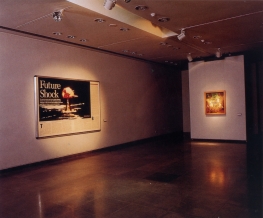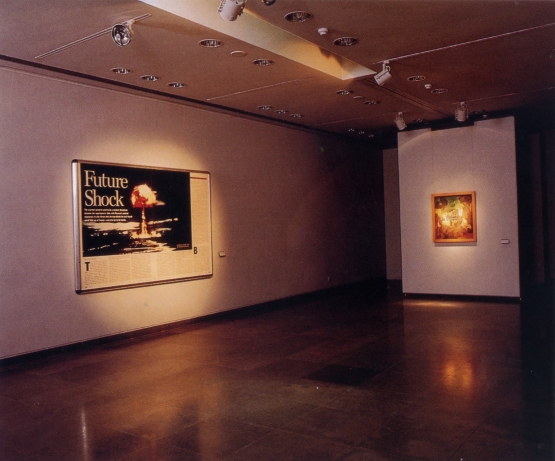
Manuel Valente Alves - Future shock
© DGPC/MNAC
Multipurpose
entry: General ConditionsWhere we come from? What are we? Where are we going to?
Manuel Valente Alves
1996-06-11
1996-06-30
Curatorship: Raquel Henriques da Silva
"Il faudrait que je le trouve le sens avant de commencer"
Marcel Duchamp in Pierre Cabanne, Entretiens avec Marcel Duchamp, 1967.
"L'artiste est inconscient de ce qu'il fait, l'artiste ne sait pas ce qu'il fait"
Marcel Duchamp, quoted by Thierry de Duve in Duchamp, Colloque de Cerisy, 1979.
The two quotations from Duchamp which I have chosen as an epigraph for this foreword may appear to be (are?.) contradictory, though they are in agreement with the always hidden attitude of their author. Apparently, "the meaning before beginning" will extract unawareness of the state of inspiration from the artist, distilling it, better yet, conceptualizing it. The truth, however, is that "finding meaning" is an initial attitude, delineator perhaps of a territory which itself achieves autonomy, generates real resistence and raises questions. The "meaning" (or not) is there, but the matter in its objectual density is not only an idea, it also forms a pathway, confronts the memory of the creator and in a variety of meanings interweaves it with the memory (the bodies and history) of others who approach it. I believe that only in this space does the object or the plastic situation acquire final meaning/s, the first in a chain which each and every glance constantly renews. With reflection and/or affection.
This point of departure was suggested by the deliberately enunciative, descriptive intentionalities of the installation by Manuel Valente Alves. He suggests a very controlled confusion of contaminations in the continuity of his work which is now being systematically strengthened by the use of quotations. For a place which is pan of a museum he evokes three personalities who could never have met: Giorgione, through his famed "Tempesta" of 1509, Paul Gauguin, by the title of an absent work dated 1897 and Bernard Hermann, via a photograph framed in a text by John Barry published in "Newsweek" in 1995.
They are referred to later but with a subtle variation. Giorgione is copied in the same format, a printed replica constructed on canvas using acrylic not oil as the medium which brings about a slight change in the nuances and tones. A disturbing deviance is created on the surface of the glass box which contains the work; and it is not "Tempesta", but "Future Shock" which causes it. As to the photograph, its enlargement and isolation from the rest of the magazine, which previously made it appear normal, is now enveloped in a scenography covering an outdoor frame called "Storm", which also creates a deviant effect. Alone, reduced to a minimum, the title of Gauguin's painting evokes its splendour to the amateur but becomes something else: such is the organizing "sense" of this puzzle of criss-cross quotations, enveloping and mingling functions, poetics and techniques or rewriting them in a new place which is that of Valente Alves himself.
That is why this installation in its descriptive clarity is a three phase construction: the first defined by the objects themselves - an oil painting, a printed photograph on the page of a magazine, a title: the second by the appropriations which it reconstitutes - the method of presentation, the exchange of captions, the decontexualization of the phrase by Gauguin: the third by the unifying significance that recharges all previous ones: the world is threatening but the core of this threat lies in the devastating effect of its power.
This deliberate message is, nevertheless, constituted as a complex statement. If the photograph in Newsweek has the overwhelming transparency of the images which sweep through our everyday lives and the phrase by Gauguin rethorically proclaims a kind of intrinsic onthology of history, "Tempesta" by Giorgione presents an intriguing metaphor. Although Valente Alves explains it in the catalogue text as a recent and convincing iconographic key, the storm is merely a symbol of Italian political strife between various condottieri, the figural pregnancy of the memory of his erudite pre-Naturalism affords the spectator the nostalgic confrontation between the organic rhythms of destruction - a sudden flash of lightning which threatens the untouched landscape and pure humanity -and the technological perversion of the bomb where the absence of people only accentuates evidence of death. This allows the painter to suggest that it was recent history that transmuted the threatening of the world into a menacing situation, using Gauguin to challenge the two situations, at one and the same rime a historic, existential scream and an anguished interpellation of the barbaric present. It is not the shame of our ignorance which we contest, although it is evoked, but the risk that we shall not be able to go on questioning.
Manuel Valente Alves follows one of the most marked of today's trends with this work. Erasing margins between painting and photography, between images appropriate to one or the other, disseminating meanings and poetics, selecting and transposing plastic mediums, inscribing and changing successive realities into a real other which questions his very transpositions. He re-situates artistic practice in an ample cultural space to which the word is a significant link, and in this way endows it with political, social and ecological intentionality, so it becomes the producer of a celebrating and intervening play where the public discover signs and recognize themselves and their situation. It is a call for action.
Returning to the original epigraph, Manuel Valente Alves starts, as Duchamp intended, from a strong determination of "meaning before beginning" but his discursiveness is an open place, experiential and perilous, the rings of which are organized fusionally and the spiral of which, like a vertical palimpsest, he makes no attempt to control. That this place of formation and representation is installed in traditional museum space asks the last, silent question: how can our lives be ordered and how can that of our dead be assured?
Raquel Henriques da Silva
On Exhibition
The Ascension of Mont Ventoux
Manuel Valente Alves
2025-10-26
2026-02-16
Curatorship: Lúcia Saldanha
Photographs, drawings and paintings, by Manuel Valente Alves that develop a poetic dialogue with Petrarch's letter of the same name (Ascensus Montis Ventosi), written in 1336.
.
2025-10-16
2026-02-01
Curatorship: Susana Lourenço Marques, Emília Tavares
This exhibition, in partnership with the Porto Museum, presents the work of three amateur photographers - Margarida Relvas, Mariana Relvas and Maria da Conceição de Lemos Magalhães - developed in Portugal between 1860-1920.
Mily Possoz. A poetics of space
2025-10-01
2026-02-01
Curatorship: Emília Ferreira
The exhibition “Mily Possoz. A Poetics of Space” continues the research into the lesser-studied Portuguese modernists artists present in the collections of the MNAC and Millennium bcp.
Impressões Digitais. MNAC Collection
2024-12-12
2026-12-30
Curatorship: Ana Guimarães, Emília Ferreira, Maria de Aires Silveira e Tiago Beirão Veiga
Consisting of founding works of contemporary Portuguese art historiography, from 1850 to the present day, the MNAC's collection holds several national treasures.
Since 1911
2022-05-26
2026-05-26
An intervention that celebrates 110 years of the MNAC.










